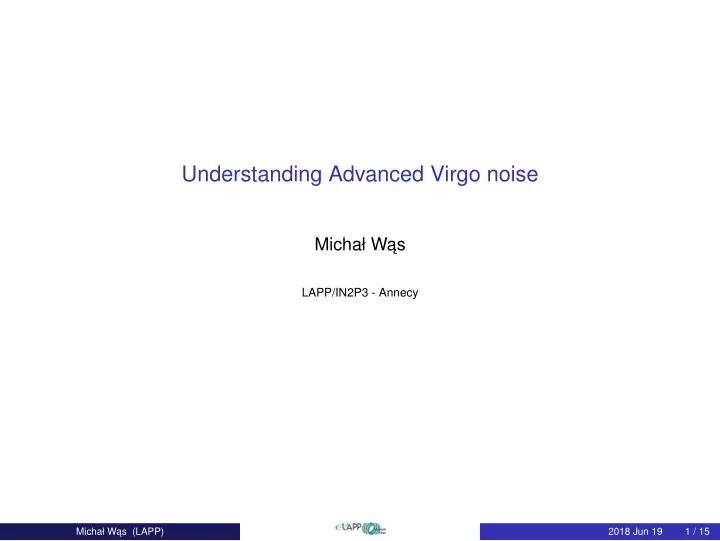

def Understanding Advanced Virgo noise Michał W ˛ as LAPP/IN2P3 - Annecy Michał W ˛ as (LAPP) 2018 Jun 19 1 / 15
def Advanced Virgo full noise budget Michał W ˛ as (LAPP) 2018 Jun 19 2 / 15
def Noise budget basics Usually consider linear coupling noise contribution to strain = TF coupling function × S noise level Coupling function TF coupling function ◮ modeled ◮ modeled with factors measured online - frequency noise (losses & assymetry) ◮ measured through noise injections - angular noise Noise level S noise level ◮ modeled - shot noise ◮ measured offline - DAC noise ◮ measured online with auxiliary channels - angular noise Add in quadrature all the noise contributions Michał W ˛ as (LAPP) 2018 Jun 19 3 / 15
def Building a complete interferometer model Frequency and amplitude ad-hoc model From PD to DOF Optickle model From DOF to feedback An IMC model not used Suspension response & noise Construct a simulink diagram of the interferometer Double pendulum to model suspensions Use simulation to compute optical response Include many degrees of freedom: ◮ DARM: differential arm length ◮ CARM: common arm length / laser frequency ◮ MICH: Michelson ◮ PRCL: power recycling cavity length Michał W ˛ as (LAPP) 2018 Jun 19 4 / 15
def ITF model → a rough calibration of DARM into h(t) Matches well proper data calibration Michał W ˛ as (LAPP) 2018 Jun 19 5 / 15
def Advanced Virgo full noise budget Michał W ˛ as (LAPP) 2018 Jun 19 6 / 15
def Advanced Virgo main limitations Michał W ˛ as (LAPP) 2018 Jun 19 7 / 15
def Demodulation phase noise - a bilinear coupling Q phase Phase fluctuation Projected noise I phase δ I ( t ) = Q ( t ) × δφ ( t ) Large offset an issue ⇒ Uncontrolled degrees of freedom are an issue Michał W ˛ as (LAPP) 2018 Jun 19 8 / 15
def Scattered light 300mW 70mW mirrors 3 km L y beam splitter 300mW 13 W 500 W 70 kW resonant cavity laser power 13W L x recycling 20mW mirror photo-detector 300mW >90% of injected light lost inside the interferometer ◮ absorption in mirrors (causes thermal lensing) ◮ mirror imperfection ⇒ scattered light ⇒ put absorbing materials everywhere Difficult, measure light phase with 10 − 12 precision ⇒ ∼ 1 photon per second in 100 kW Michał W ˛ as (LAPP) 2018 Jun 19 9 / 15
def Scattered light - a non linear coupling ∼ 10 % of light detected at various ports Non linear coupling of scattering surface motion x ( t ) � 4 π � n ( t ) = K sin λ x ( t ) ◮ Move in a controlled way different benches to locate coupling ◮ In bad weather ground motion at 0.3Hz leads to noise up to 50Hz Michał W ˛ as (LAPP) 2018 Jun 19 10 / 15
def Brute force coherence to understand noise drifts Observed wandering line Found correlation Track frequency of a moving line Correlate with slow monitoring, e.g. temperature Automated blind search on thousands of channels Michał W ˛ as (LAPP) 2018 Jun 19 11 / 15
def GW sensitivity smallest observable GW amplitude ∝ S ( f ) × S/N threshold Astrophysical triggers, GW models, etc ... changes search parameter space ⇒ S/N threshold depends on the search hypothesis Michał W ˛ as (LAPP) 2018 Jun 19 12 / 15
def Modeled inspiral search 3 10 inspiral Gaussian 2 10 X: 9.2 Y: 6.9 1 10 0 10 Rate [yr −1 ] −1 10 −2 10 −3 10 X: 11 Y: 6.2e−05 −4 10 8 9 10 11 12 13 14 coherent SNR For modeled search noise is close to Gaussian Michał W ˛ as (LAPP) 2018 Jun 19 13 / 15
def Non stationary noise impact depends on GW search type 3 10 Gaussian inspiral X: 8.3 2 10 burst >200Hz Y: 32 burst <200Hz 1 10 0 X: 13 10 Rate [yr −1 ] Y: 0.18 −1 10 −2 10 −3 10 −4 10 8 9 10 11 12 13 14 coherent SNR Unmodeled transient searches are more affected by transient noise Michał W ˛ as (LAPP) 2018 Jun 19 14 / 15
def Summary 3 10 Gaussian inspiral X: 8.3 2 10 burst >200Hz Y: 32 burst <200Hz 1 10 0 X: 13 10 Rate [yr −1 ] Y: 0.18 −1 10 −2 10 −3 10 −4 10 8 9 10 11 12 13 14 coherent SNR Both stationary spectrum and short transients limit detector sensitivity Global instrument simulations help understanding cross-coupling Shaking instrument in different ways allows to measure coupling Looking for time correlations helps finding origin of issues Michał W ˛ as (LAPP) 2018 Jun 19 15 / 15
Recommend
More recommend